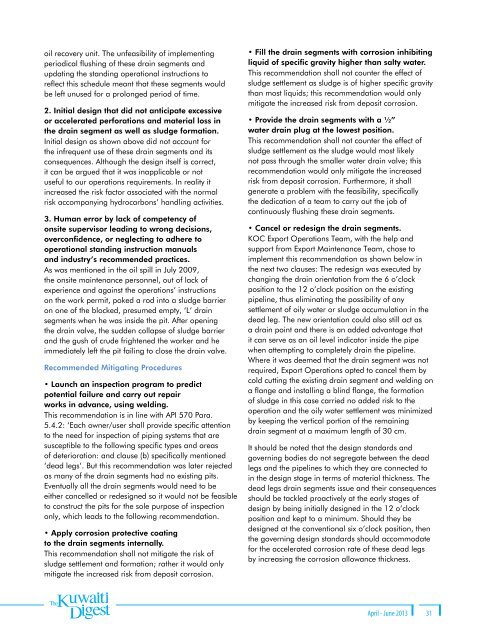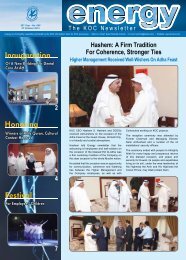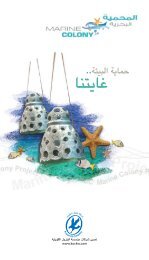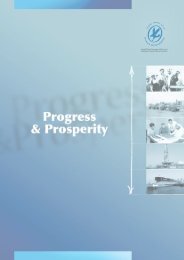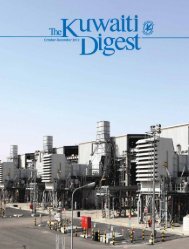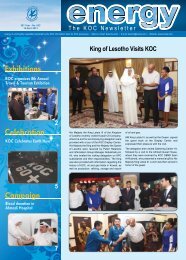6 - Kuwait Oil Company
6 - Kuwait Oil Company
6 - Kuwait Oil Company
You also want an ePaper? Increase the reach of your titles
YUMPU automatically turns print PDFs into web optimized ePapers that Google loves.
oil recovery unit. The unfeasibility of implementing<br />
periodical flushing of these drain segments and<br />
updating the standing operational instructions to<br />
reflect this schedule meant that these segments would<br />
be left unused for a prolonged period of time.<br />
2. Initial design that did not anticipate excessive<br />
or accelerated perforations and material loss in<br />
the drain segment as well as sludge formation.<br />
Initial design as shown above did not account for<br />
the infrequent use of these drain segments and its<br />
consequences. Although the design itself is correct,<br />
it can be argued that it was inapplicable or not<br />
useful to our operations requirements. In reality it<br />
increased the risk factor associated with the normal<br />
risk accompanying hydrocarbons’ handling activities.<br />
3. Human error by lack of competency of<br />
onsite supervisor leading to wrong decisions,<br />
overconfidence, or neglecting to adhere to<br />
operational standing instruction manuals<br />
and industry’s recommended practices.<br />
As was mentioned in the oil spill in July 2009,<br />
the onsite maintenance personnel, out of lack of<br />
experience and against the operations’ instructions<br />
on the work permit, poked a rod into a sludge barrier<br />
on one of the blocked, presumed empty, ‘L’ drain<br />
segments when he was inside the pit. After opening<br />
the drain valve, the sudden collapse of sludge barrier<br />
and the gush of crude frightened the worker and he<br />
immediately left the pit failing to close the drain valve.<br />
Recommended Mitigating Procedures<br />
• Launch an inspection program to predict<br />
potential failure and carry out repair<br />
works in advance, using welding.<br />
This recommendation is in line with API 570 Para.<br />
5.4.2: ‘Each owner/user shall provide specific attention<br />
to the need for inspection of piping systems that are<br />
susceptible to the following specific types and areas<br />
of deterioration: and clause (b) specifically mentioned<br />
‘dead legs’. But this recommendation was later rejected<br />
as many of the drain segments had no existing pits.<br />
Eventually all the drain segments would need to be<br />
either cancelled or redesigned so it would not be feasible<br />
to construct the pits for the sole purpose of inspection<br />
only, which leads to the following recommendation.<br />
• Apply corrosion protective coating<br />
to the drain segments internally.<br />
This recommendation shall not mitigate the risk of<br />
sludge settlement and formation; rather it would only<br />
mitigate the increased risk from deposit corrosion.<br />
• Fill the drain segments with corrosion inhibiting<br />
liquid of specific gravity higher than salty water.<br />
This recommendation shall not counter the effect of<br />
sludge settlement as sludge is of higher specific gravity<br />
than most liquids; this recommendation would only<br />
mitigate the increased risk from deposit corrosion.<br />
• Provide the drain segments with a ½”<br />
water drain plug at the lowest position.<br />
This recommendation shall not counter the effect of<br />
sludge settlement as the sludge would most likely<br />
not pass through the smaller water drain valve; this<br />
recommendation would only mitigate the increased<br />
risk from deposit corrosion. Furthermore, it shall<br />
generate a problem with the feasibility, specifically<br />
the dedication of a team to carry out the job of<br />
continuously flushing these drain segments.<br />
• Cancel or redesign the drain segments.<br />
KOC Export Operations Team, with the help and<br />
support from Export Maintenance Team, chose to<br />
implement this recommendation as shown below in<br />
the next two clauses: The redesign was executed by<br />
changing the drain orientation from the 6 o’clock<br />
position to the 12 o’clock position on the existing<br />
pipeline, thus eliminating the possibility of any<br />
settlement of oily water or sludge accumulation in the<br />
dead leg. The new orientation could also still act as<br />
a drain point and there is an added advantage that<br />
it can serve as an oil level indicator inside the pipe<br />
when attempting to completely drain the pipeline.<br />
Where it was deemed that the drain segment was not<br />
required, Export Operations opted to cancel them by<br />
cold cutting the existing drain segment and welding on<br />
a flange and installing a blind flange, the formation<br />
of sludge in this case carried no added risk to the<br />
operation and the oily water settlement was minimized<br />
by keeping the vertical portion of the remaining<br />
drain segment at a maximum length of 30 cm.<br />
It should be noted that the design standards and<br />
governing bodies do not segregate between the dead<br />
legs and the pipelines to which they are connected to<br />
in the design stage in terms of material thickness. The<br />
dead legs drain segments issue and their consequences<br />
should be tackled proactively at the early stages of<br />
design by being initially designed in the 12 o’clock<br />
position and kept to a minimum. Should they be<br />
designed at the conventional six o’clock position, then<br />
the governing design standards should accommodate<br />
for the accelerated corrosion rate of these dead legs<br />
by increasing the corrosion allowance thickness.<br />
April - June 2013 31


